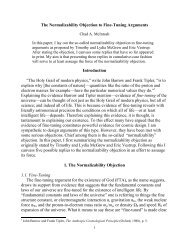Theism and Explanation - Appeared-to-Blogly
Theism and Explanation - Appeared-to-Blogly
Theism and Explanation - Appeared-to-Blogly
Create successful ePaper yourself
Turn your PDF publications into a flip-book with our unique Google optimized e-Paper software.
Notes 181<br />
19. Swinburne, Is There a God? 52.<br />
20. Swinburne, Existence of God, 70.<br />
21. Maher, “Confi rmation Theory,” 1.<br />
22. Sober, “Design Argument,” 29. It would be better <strong>to</strong> say that it is the observation<br />
that is made likely by the hypothesis rather than (as Sober does) that<br />
the hypothesis is made likely. The latter way of expressing the distinction<br />
actually confuses the two issues.<br />
23. Varying the fi gures shows that the higher the prior probability of the evidence,<br />
the less signifi cance can be attributed <strong>to</strong> a likelihood calculation. Let’s<br />
say that the probability of what we observe (E) is not so surprising a fact,<br />
that its probability is, say 0.5. Then on the other fi gures I’ve given, the probability<br />
of the hypothesis (H) is raised only marginally (<strong>to</strong> 0.18). This is worth<br />
noting, since at least some of the facts which theists attempt <strong>to</strong> explain will<br />
not be particularly surprising, particularly if they have well-corroborated<br />
natural explanations (4.3.3.1).<br />
24. In doing so, he allows the earlier arguments <strong>to</strong> lend cumulative force <strong>to</strong> the<br />
latter (Existence of God, 12–13), a procedure <strong>to</strong> which I have no in principle<br />
objection, but which I shall not discuss here.<br />
25. Swinburne, Existence of God, 109.<br />
26. Ibid., 53.<br />
27. Ibid., 66.<br />
28. Ibid., 341.<br />
29. Ibid., 329. There is a person-relative aspect <strong>to</strong> Swinburne’s argument from<br />
religious experience. For although it does give a role <strong>to</strong> testimony (ibid., 322–<br />
24), it largely rests on his “principle of credulity” (ibid., 303), which states<br />
that “if it seems (epistemically) <strong>to</strong> a subject that x is present (<strong>and</strong> has some<br />
characteristic), then probably x is present (<strong>and</strong> has that characteristic).”<br />
30. Swinburne, Existence of God, 341.<br />
31. Ibid., 342.<br />
32. Plantinga, Warranted Christian Belief, 272–80.<br />
33. Swinburne, Existence of God, 328.<br />
34. The article in question, Meyer’s “Origin of Biological Information,” was<br />
published in the Proceedings of the Biological Society of Washing<strong>to</strong>n in<br />
2004, becoming the fi rst work advocating “design theory” <strong>to</strong> be published<br />
in a peer-reviewed scientifi c journal. On September 7 that year, the Biological<br />
Society of Washing<strong>to</strong>n published a statement repudiating both the article<br />
<strong>and</strong> intelligent design theory. (The statement is available at http://www.biolsocwash.org.)<br />
For a less than positive review, see Gishlick, Matzke <strong>and</strong> Elsberry’s<br />
“Meyer’s Hopeless Monster.”<br />
35. Swinburne, Existence of God, 23.<br />
36. Meyer, “Return of the God Hypothesis,” 27; Peacocke, Paths from Science<br />
<strong>to</strong> God, 32–36; Banner, Justifi cation of Science, 125–53.<br />
37. See, for example, Steinhardt <strong>and</strong> Turok, “A Cyclic Model of the Universe,”<br />
1436–39.<br />
38. Hempel, Philosophy of Natural Science, 7.<br />
39. Ayer, Foundations of Empirical Knowledge, 231.<br />
40. Thomson, “Cathode Rays,” 293.<br />
41. Ibid.<br />
42. Musgrave, Essays on Realism, 284. Musgrave is here adapting an example<br />
given by John Herschel (Preliminary Discourse, §138 [144–45]), although<br />
in support of rather a different position. Herschel is arguing that we should<br />
appeal <strong>to</strong> what we already know <strong>to</strong> be “true causes” (verae causae), Musgrave<br />
that we should adopt the best explanation of the phenomenon. For the<br />
relationship between the two claims, see Sects. 7.2 <strong>and</strong> 7.5.



